Learn how to cook rice in a donabe, the traditional Japanese earthenware pot, with my step-by-step tutorial. The process is simple and easy. You’ll make unbelievably fluffy and tender Japanese short-grain white rice every time! Brown rice instructions included.
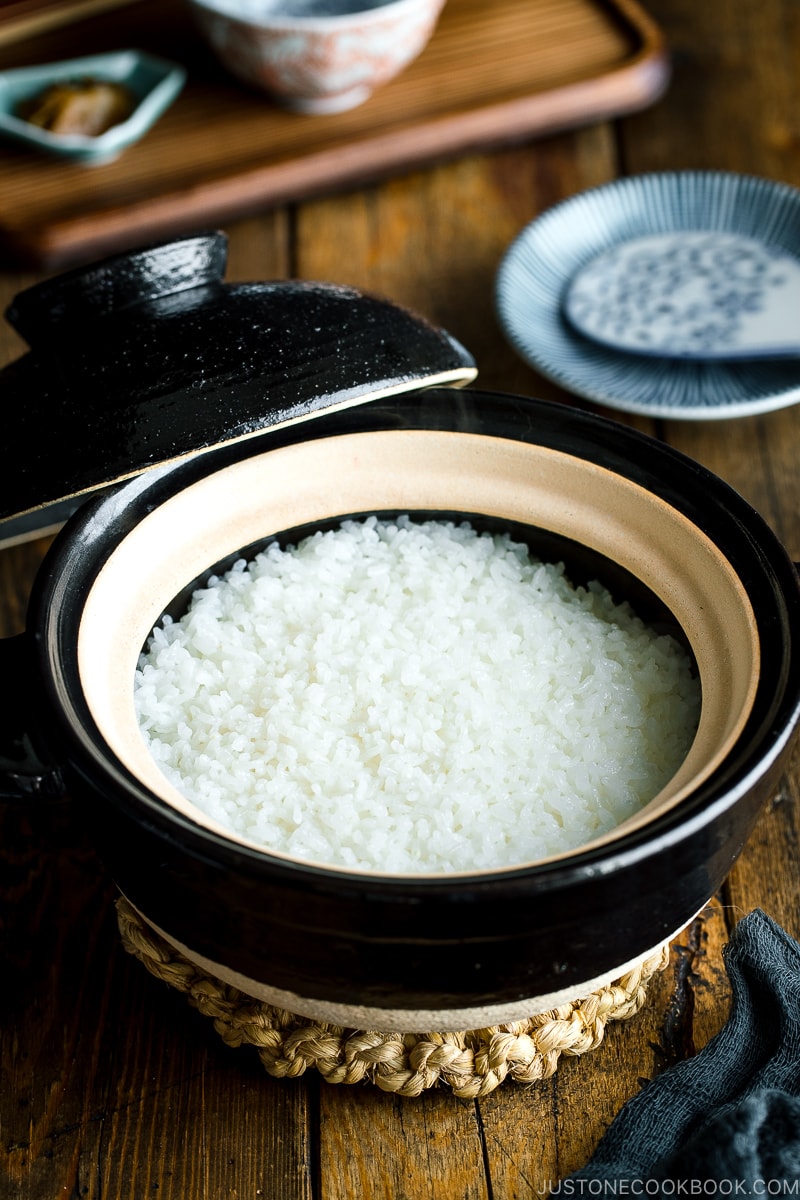
Years ago when I visited Japan, I had several occasions to eat rice cooked in a donabe (Japanese clay pot) at Japanese inns called ryokan and at rice specialty restaurants. It utterly blew my mind. The rice was unbelievably tender and fluffy—so tasty that I could not stop thinking about it!
At home, I’d been using my reliable rice cooker that made good, decent rice. And I had eaten rice made in a donabe countless times growing up. But this time, I was determined to start using a donabe that’s made just for cooking rice. My quest did not disappoint! Let me show you how I cook rice in a donabe in this tutorial and recipe.
Table of Contents
- What is Donabe?
- Why You’ll Love This Recipe
- Can I Cook Brown Rice in a Donabe?
- The Right Rice-to-Water Ratio for Short-Grain White Rice
- Ingredients You’ll Need To Make White Rice in a Donabe
- How To Cook Short-Grain White Rice in a Donabe
- How Much Rice Do I Need to Cook?
- Cooking Tips for Donabe Rice
- My Two Favorite Donabe Rice Cookers
What is Donabe?
Donabe (土鍋) is a centuries-old Japanese cooking vessel made of special clay. It holds heat exceptionally well, which makes it ideal for dishes that require liquid and long cooking times. A highly versatile tool for everyday cooking, donabe come in different sizes and variations to suit the ingredients or servings you’re preparing.
Donabe is essentially the ultimate one-pot wonder. You may be familiar with these earthenware vessels used to make Shabu Shabu and other hot pot dishes. Donabe is excellent for making soups, stews, and braised dishes as well as steamed and roasted foods. It also cooks the most amazing rice you’ve ever had!
I believe that a Japanese clay pot has the best capability to cook rice. In today’s recipe, I’m using a donabe rice cooker, which is specifically designed just for this task.
Why You’ll Love This Recipe
- Cook your rice perfectly in a donabe.
- Make the most delicious rice, simply put—so fluffy and tender!
- Retain heat and moisture. A donabe keeps your food so warm.
- Simple, rustic, and gorgeous tableware in which to serve your rice.
- Easy to use and maintain.
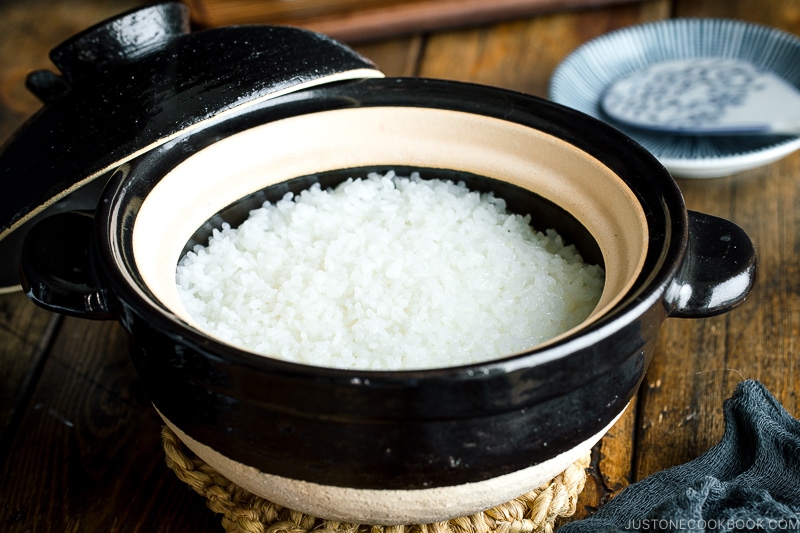
Making rice with a handmade donabe also brings a more profound and sacred experience of the tradition of cooking rice. A high-quality donabe is not cheap, but it’s the best rice cooker your money can buy. The donabe will be your lifelong companion in the kitchen.
Can I Cook Brown Rice in a Donabe?
Yes, you can. However, the soaking time, cooking time, and steaming (resting) time for Japanese short-grain brown rice are all much longer than for white rice. Also, the rice-to-water ratio is 1 to 1.6 (or 1.7) for Japanese short-grain brown rice, so you’ll have to add more water for brown rice compared to white rice.
For the purposes of this tutorial, I’ll explain the process for cooking white rice. Please see the recipe card below for the complete instructions for how to cook brown rice in a donabe.
The Right Rice-to-Water Ratio for Short-Grain White Rice
The Japanese golden ratio for white rice to water is 1 to 1.1 (or 1.2). This means to cook 1 part Japanese short-grain white rice in 1.1 or 1.2 parts room-temperature water.
In Japan, we measure uncooked rice using the plastic rice cooker cup that comes with the rice cooker. This rice cooker cup measures ¾ cup (180 ml) and we call that amount ichi go (一合).
Here’s how much water you need for each rice cooker cup of uncooked short-grain white rice following the 1-to-1.1 (or 1.2) ratio:
1 rice cooker cup (180 ml) = add 200 ml of water
2 rice cooker cups (360 ml) = 400 ml
3 rice cooker cups (540 ml) = 600 ml
4 rice cooker cups (720 ml) = 800 ml
5 rice cooker cups (900 ml) = 1000 ml
Calculation: 180 ml x 1.1 (or 1.2) = 198 ml (or 216 ml)
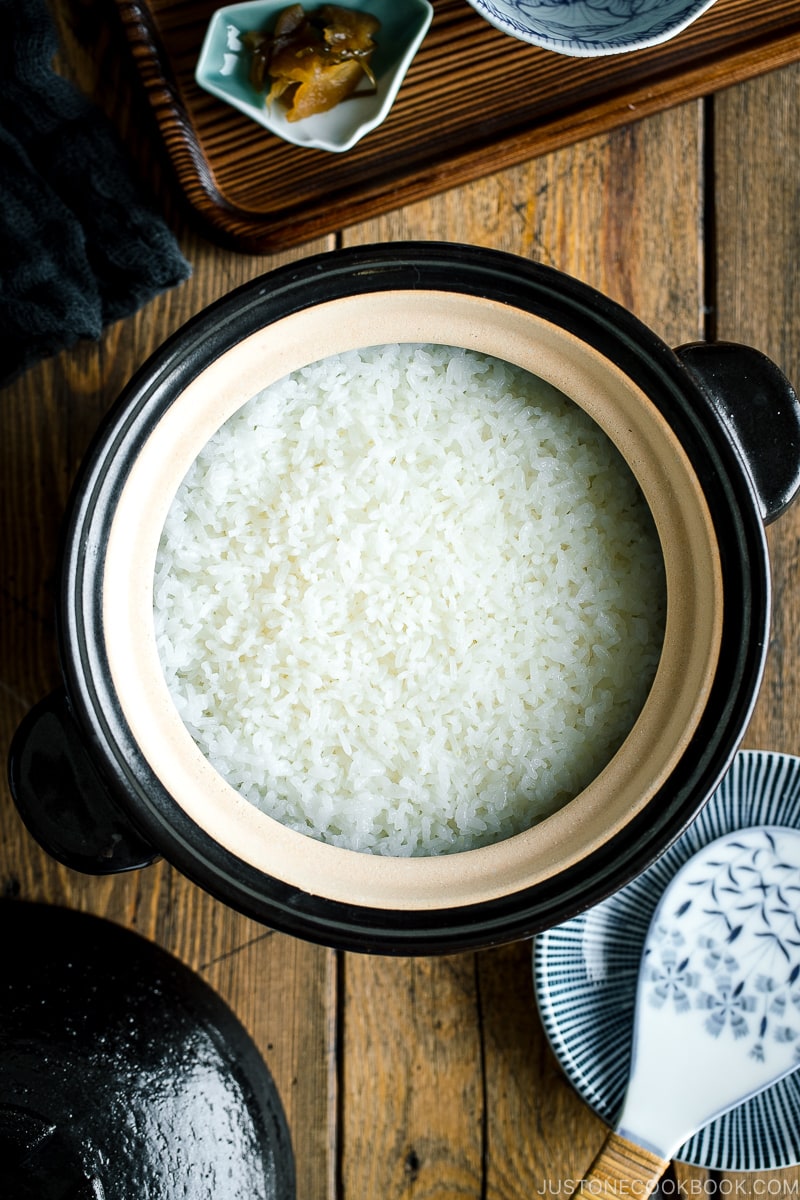
Ingredients You’ll Need To Make White Rice in a Donabe
- Japanese short-grain white rice
- Water (at room temperature)
How To Cook Short-Grain White Rice in a Donabe
- Measure the rice. Overfill your rice cooker cup (or US measuring cup) with uncooked rice, then level it off.
- Wash and rinse. Start with an initial quick rinse, then wash and rinse the rice three times. See the recipe card for my detailed step-by-step instructions.
- Drain the rice very well. Use a fine-mesh sieve and shake off any excess water. Place in the donabe.
- Add the measured water.
- Soak the white rice for 20–30 minutes. This is very important! Don’t skip soaking.
- Set the donabe on a gas stove top. Make sure to dry the bottom of your donabe with a towel, first. Place the lid on top.
- Cook the white rice over medium-high heat for 13–15 minutes. Turn off the heat.
- Steam the cooked white rice for 20 minutes with the lid on (don’t open the lid).
- Fluff the rice. Insert a rice paddle vertically into the cooked rice and turn over a scoop from the bottom. Then, use a slicing motion to fluff it. Repeat, then enjoy!
How Much Rice Do I Need to Cook?
See how much rice to cook for how many servings you need:
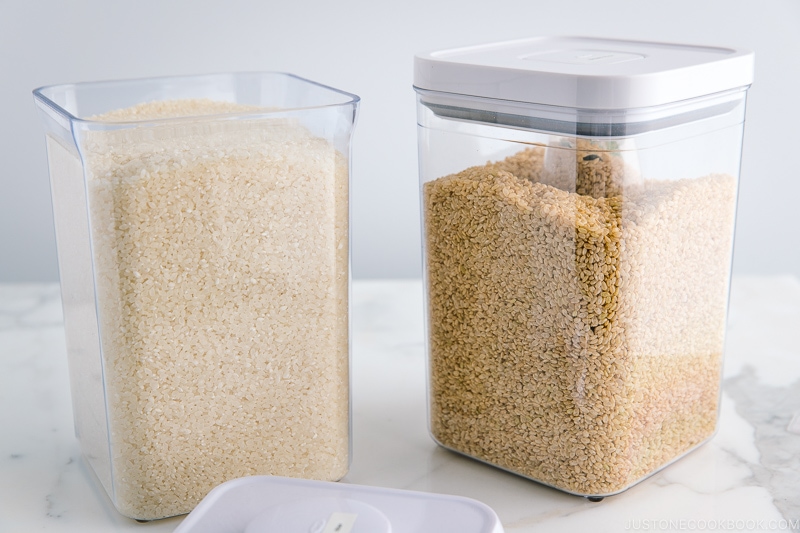
- 1 rice cooker cup (180 ml, ¾ cup, 150 g) of uncooked short-grain white rice
- 2¼ cups or 330 g of cooked rice
- 2 rice bowls
- 3 onigiri rice balls
- 1 donburi bowl
- 2¼ cups or 330 g of cooked rice
- 2 rice cooker cups (360 ml, 1½ cups, 300 g) of uncooked rice
- 4⅓ cups, 660 g of cooked rice
- 4 rice bowls
- 6 onigiri rice balls
- 2.5 donburi bowls
- 4⅓ cups, 660 g of cooked rice
- 3 rice cooker cups (540 ml, 2¼ cups, 450 g) of uncooked rice
- 6⅔ cups or 990 g of cooked rice
- 6 rice bowls
- 9 onigiri rice balls
- 4 donburi bowls
- 6⅔ cups or 990 g of cooked rice
- 4 rice cooker cups (720 ml, 3 cups, 600 g) of uncooked rice
- 8¾ cups or 1320 g of cooked rice
- 8 rice bowls
- 12 onigiri rice balls
- 5 donburi bowls
- 8¾ cups or 1320 g of cooked rice
- 5 rice cooker cups (900 ml, 3¾ cups, 750 g) of uncooked rice
- 11 cups or 1650 g of cooked rice
- 10 rice bowls
- 15 onigiri rice balls
- 6 donburi bowls
- 11 cups or 1650 g of cooked rice
Helpful Notes to Remember:
- A typical rice bowl serving is 1 cup (150 g) of cooked rice.
- A typical donburi bowl serving is 1⅔ cups (250 g) of cooked rice.
- A typical onigiri (rice ball) weighs 3.9 oz (110 g) each.
- One cup of cooked brown rice weighs 5.3 oz (150 g).
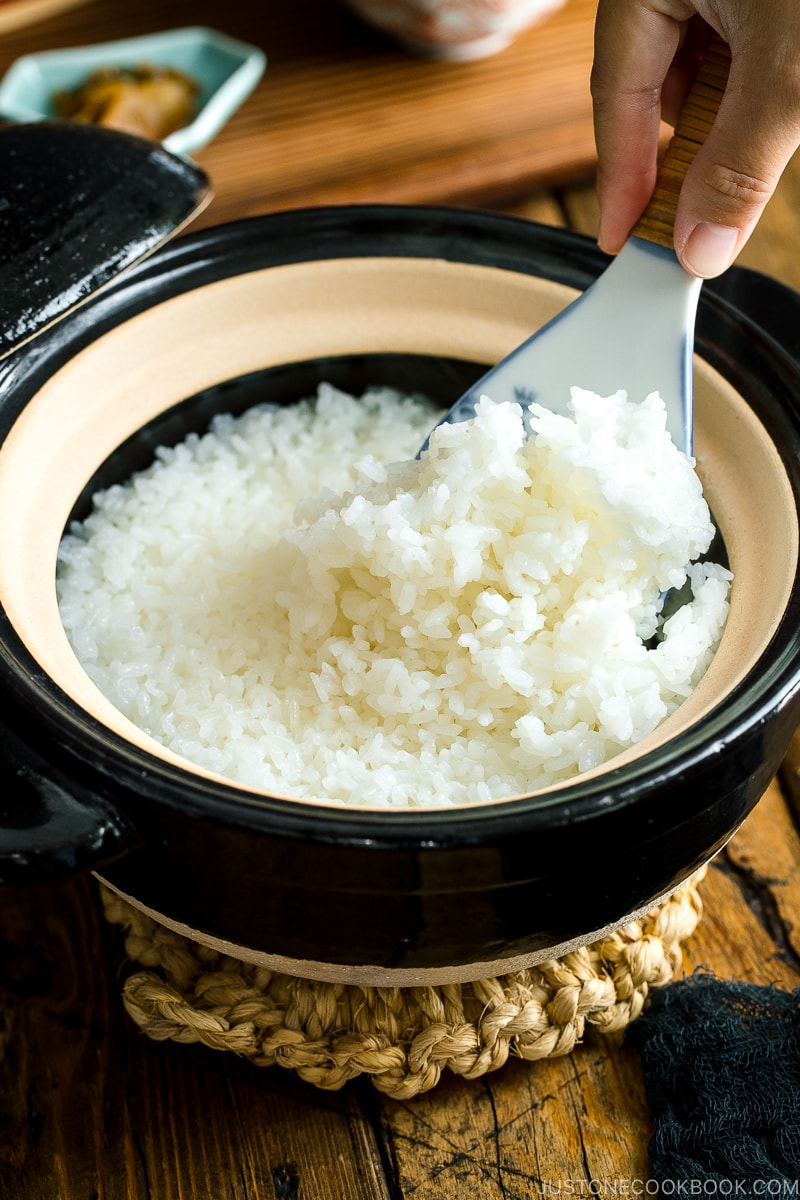
Cooking Tips for Donabe Rice
- Always rinse and wash the rice. We always quickly rinse and wash the rice a few times. This is important to help remove impurities and the natural occurrence of arsenic on the rice.
- Short-grain rice always requires soaking (20–30 minutes), unlike other kinds of rice. The rice grains are rounder and fatter, so they need a head start to absorb moisture to the core of the kernel.
- Dry the bottom of the donabe with a towel. Otherwise, the donabe will crack.
- Never use high heat. Use medium-high (or medium heat for the commercial-grade stove).
- Let the cooked rice steam for 20 minutes when it’s done cooking. Steaming is essential! It’s the final step in cooking Japanese rice. Without it, your rice will not cook fully. Resist the urge to peek under the lid during this time. If you open the lid, you’ll release the precious steam crucial for this resting period.
- When you use new crop rice (新米), reduce the water slightly.
- When you get a different brand of rice, test cooking the rice and adjust the amount of water, if needed.
- The more rice you have in the pot, the more delicious your cooked rice will be. That’s because the most evenly cooked rice is in the center of the pot. The rice near the bottom and top simply cooks too fast. More rice in the pot means you’ll increase the central proportion of steamed rice for a more delicious outcome. That’s why I recommend cooking at least 2–3 rice cooker cups of uncooked rice at a time, even if you need less. You can always freeze the extra rice with good results.
My Two Favorite Donabe Rice Cookers
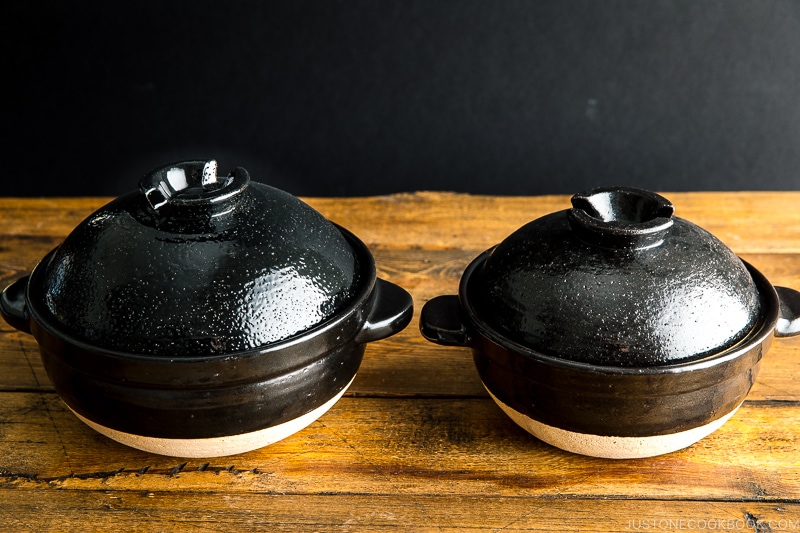
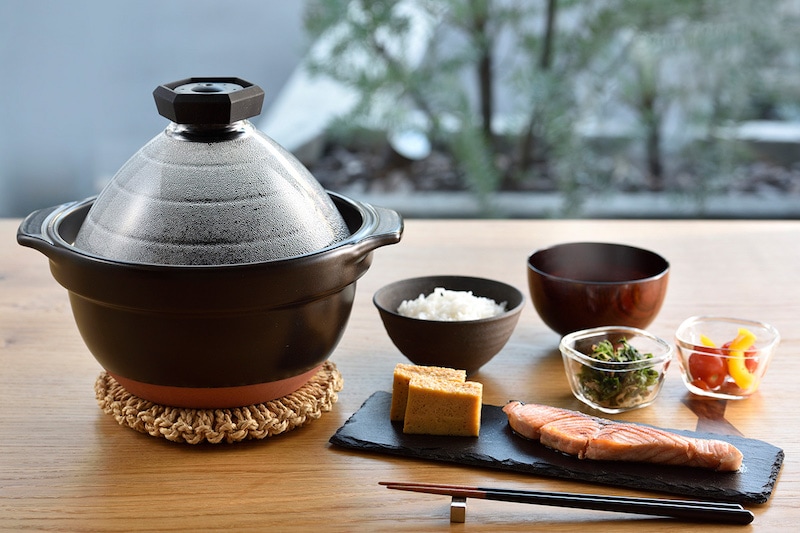
- Kamado-san – Handcrafted by skilled artisans, Kamado-san donabe is made from special clay sourced from the Iga region of Japan.
- The double lid works like a pressure cooker, so it delivers heat evenly and retains the temperature extremely well.
- It has a special glaze that helps the heat penetrate into the core of each rice grain.
- Your rice keeps warm for a long time, even after you turn off the heat.
- Hario Gohangama – I use it very frequently and absolutely love this donabe for four reasons:
- The heat-proof glass lid allows you to see the rice as it cooks.
- The donabe body is Japanese-made Bankoware (similar to my favorite blue donabe below). It’s very sturdy and won’t chip easily compared to Kamado-san. Even though it requires hand-washing, it’s very easy to clean.
- Water lines inside the donabe show you how much water to add to 2 or 3 rice cooker cups of rice. I don’t have to measure the water anymore!
- The whistle on the lid’s knob lets you know when the rice is almost done. When it starts to whistle, wait one minute then turn off the heat. Perfect rice every time!
Where to Buy a Donabe Rice Cooker
- Kamado-san: Amazon and Toiro Kitchen
- Hario Gohangama: Hario website, Food52, MTC Kitchen
You can also see my page on How To Choose the Best Donabe for your overall cooking needs.
Season Your Donabe Before First Use
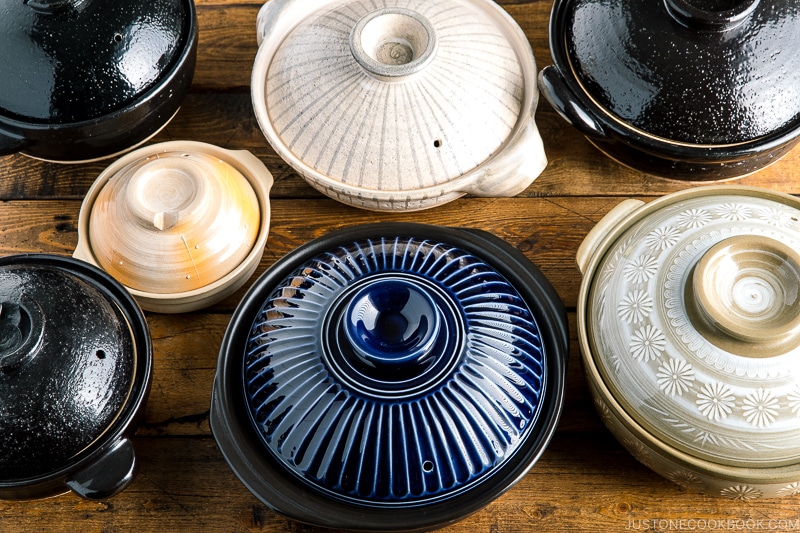
Before you use a new donabe, you must season it first. The process is simple. See my tutorial How to Season Your Donabe for instructions. In that post, I also share some incredibly useful tips on how to care for your donabe so your precious earthenware pot can last you for a lifetime.
Other Methods of Cooking Japanese Short-Grain Rice
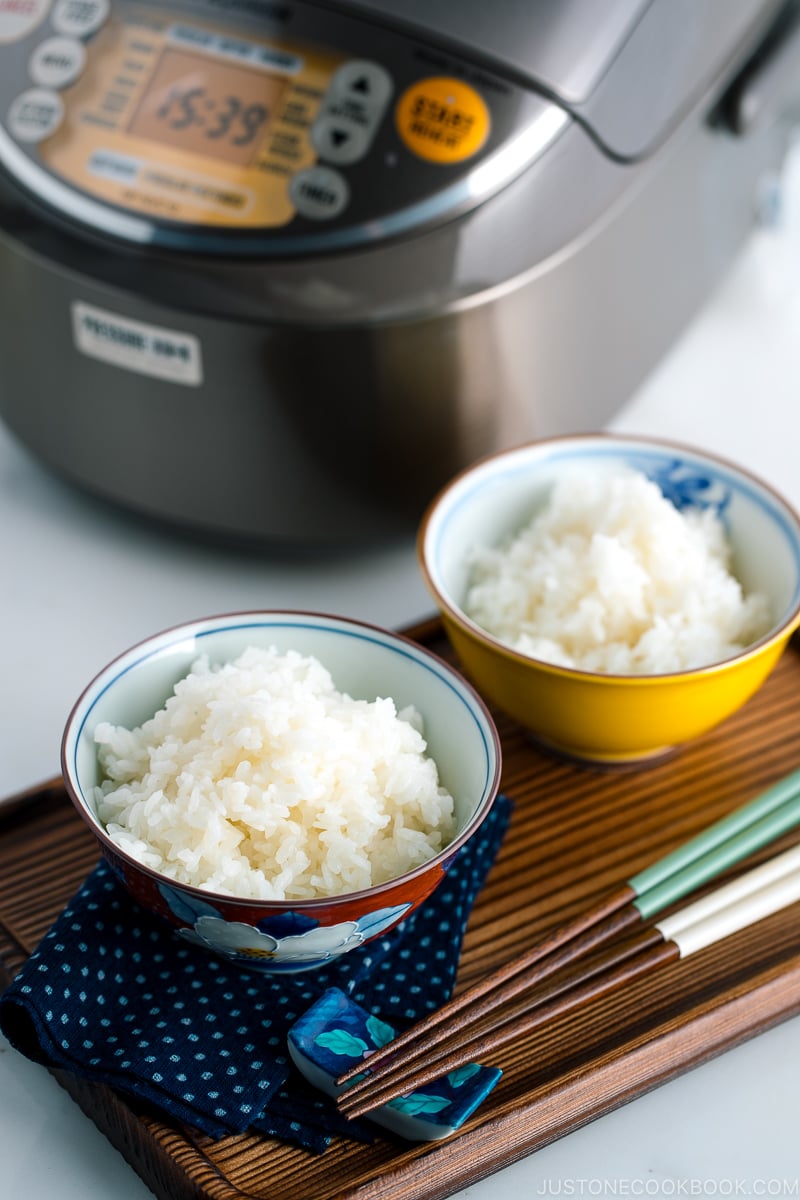
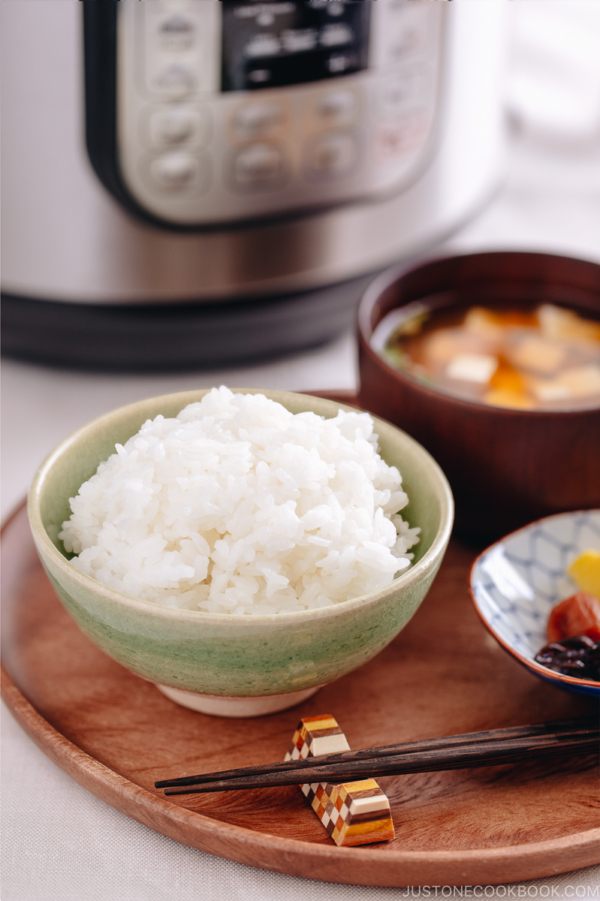
- How To Cook Rice in a Rice Cooker
- How To Cook Rice in a Pot over Stovetop
- How To Cook Rice in an Instant Pot
More Recipes Using Donabe
- Sesame Miso Hot Pot
- Mizutaki (Chicken Hot Pot)
- Bamboo Rice
- Shabu Shabu
- Sansai Gohan (Rice with Mountain Vegetables)
Wish to learn more about Japanese cooking? Sign up for our free newsletter to receive cooking tips & recipe updates! And stay in touch with me on Facebook, Pinterest, YouTube, and Instagram.
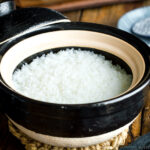
How To Cook Rice in a Donabe
Ingredients
★ WHITE RICE ★
For 2 Rice Bowls (2¼ cups, 330 g cooked rice)
- ¾ cup uncooked Japanese short-grain white rice (1 rice cooker cup, 180 ml)
- ⅞ cup water (200 ml)
For 4 Rice Bowls (4⅓ cups, 660 g)
- 1½ cups uncooked Japanese short-grain white rice (2 rice cooker cups, 360 ml)
- 1⅔ cups water (400 ml)
For 6 Rice Bowls (6⅔ cups, 990 g)
- 2¼ cups uncooked Japanese short-grain white rice (3 rice cooker cups, 540 ml)
- 2½ cups water (600 ml)
For 8 Rice Bowls (8¾ cups, 1320 g)
- 3 cups uncooked Japanese short-grain white rice (4 rice cooker cups, 720 ml)
- 3⅓ cups water (800 ml)
For 10 Rice Bowls (11 cups, 1650 g)
- 3¾ cups uncooked Japanese short-grain white rice (5 rice cooker cups, 900 ml)
- 4⅛ cups water (1000 ml)
★ BROWN RICE ★
For 2 Rice Bowls (2¼ cups, 330 g cooked rice)
- ¾ cup uncooked Japanese short-grain brown rice (1 rice cooker cup, 180 ml)
- 1¼ cups water (300 ml)
For 4 Rice Bowls (4⅓ cups, 660 g)
- 1½ cups uncooked Japanese short-grain brown rice (2 rice cooker cups, 360 ml)
- 2½ cups water (600 ml)
For 6 Rice Bowls (6⅔ cups, 990 g)
- 2¼ cups uncooked Japanese short-grain brown rice (3 rice cooker cups, 540 ml)
- 3¾ cups water (900 ml)
For 8 Rice Bowls (8¾ cups, 1320 g)
- 3 cups uncooked Japanese short-grain brown rice (4 rice cooker cups, 720 ml)
- 5 cups water (1200 ml)
For 10 Rice Bowls (11 cups, 1650 g)
- 3¾ cups uncooked Japanese short-grain brown rice (5 rice cooker cups, 900 ml)
- 6¼ cups water (1500 ml)
Instructions
- Before You Start: Please note that this recipe requires a soaking time of 20–30 minutes for white rice and 6–12 hours for brown rice. The rice-to-water ratio is 1 to 1.1 (or 1.2) for Japanese short-grain white rice and 1 to 1.6 (or 1.7) for Japanese short-grain brown rice.Please note that ¾ cup (150 g, 1 rice cooker cup) of uncooked Japanese short-grain rice yields 2¼ cups (330 g) of cooked rice. This is enough for 2 Japanese rice bowls (typically 150 g each) or 3 onigiri rice balls (typically 110 g each). 1 cup of cooked rice weighs about 5.3 oz (150 g).
- How to Measure: Overfill a US cup measure (a ¾-cup measure works well for this) or a rice cooker cup with uncooked short-grain rice and level it off. Put the rice in a large bowl. Repeat until you have the measured amount of rice needed. In this recipe, I‘m making 2 rice cooker cups of rice using my 2 rice cup size Kamado-san. You can also use a 3 rice cup size Kamado-san.
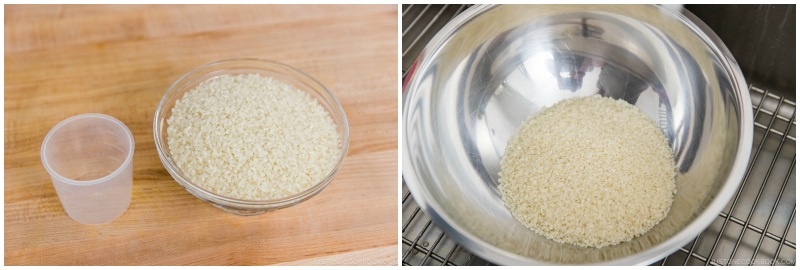
To Wash the Rice
- Gather the rice, the measured water, and a donabe.
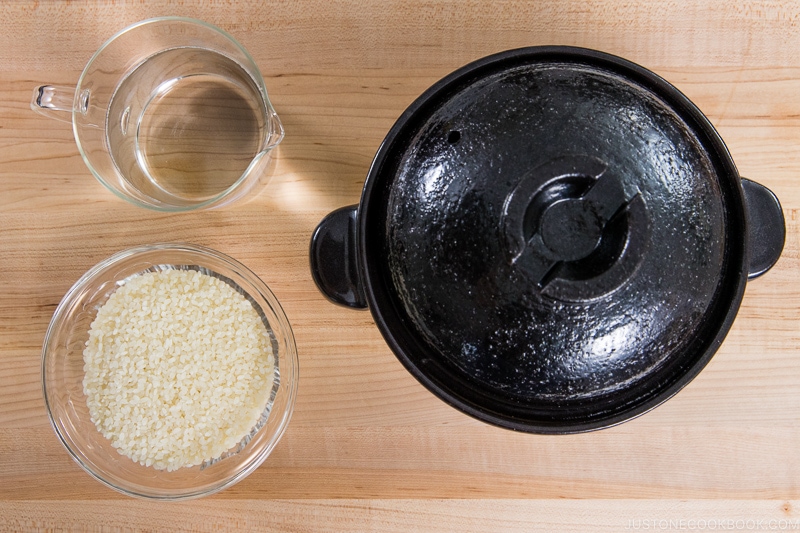
- Quick Rinse: Add just enough tap water to the bowl to submerge all the rice. Then, discard the water immediately. Repeat one more time. Tip: Rice absorbs water very quickly when you start rinsing, so this step helps remove impurities from the rice and prevent it from absorbing the first few rounds of milky water.
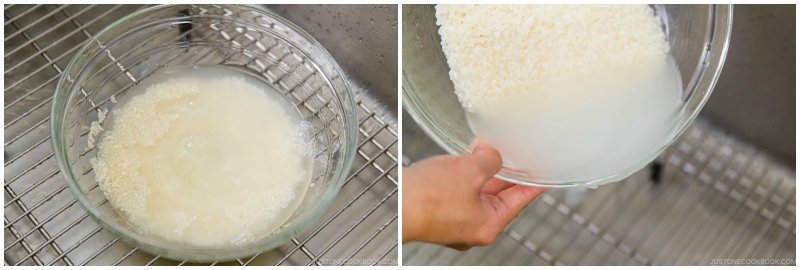
- Wash: Next, use your fingers to gently agitate the wet rice grains in a circular motion for 10–15 seconds. Using very little water allows the grains to rub against each other. It also reduces the absorption of impurities from the milky water.
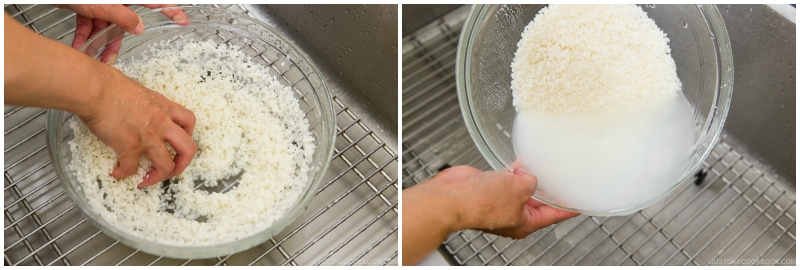
- Rinse: Add tap water and immediately discard the cloudy water. Repeat one more time.
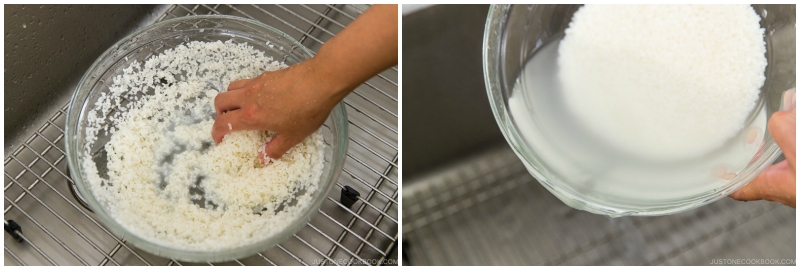
- Repeat Wash and Rinse (steps 3 and 4) two more times.
- Drain: When the water is almost clear, drain the rice very well. Tip: Use a fine-mesh sieve to drain and shake off any excess water.
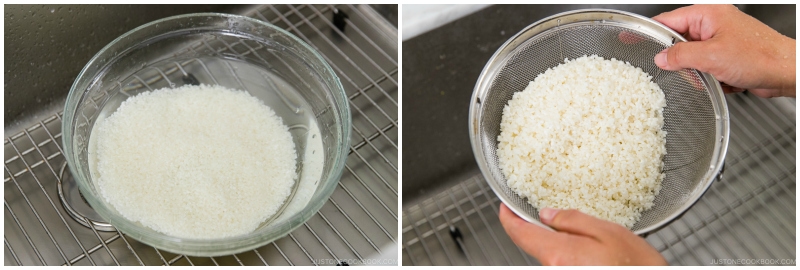
To Soak the Rice
- Transfer the well-drained rice to the donabe and add the measured amount of water (see below to find the water measurement for your amount of rice). Gently shake the pot and use your fingers to level the rice so that it‘s evenly distributed and submerged in the water.
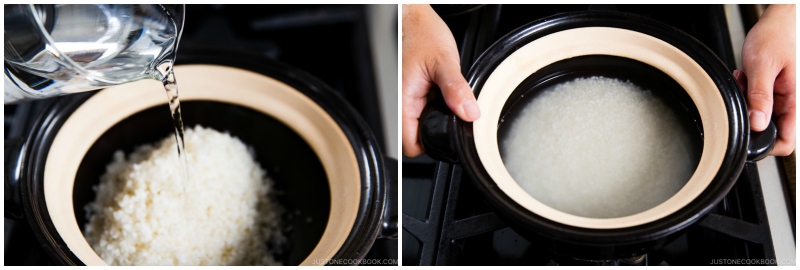
- Place the lid (or both lids of the Kamado-san) on the pot and soak the rice in the donabe for 20–30 minutes. If you‘re cooking brown rice, it requires 12 hours of soaking time. You can also add a pinch of salt to help reduce the bitterness of brown rice (optional).
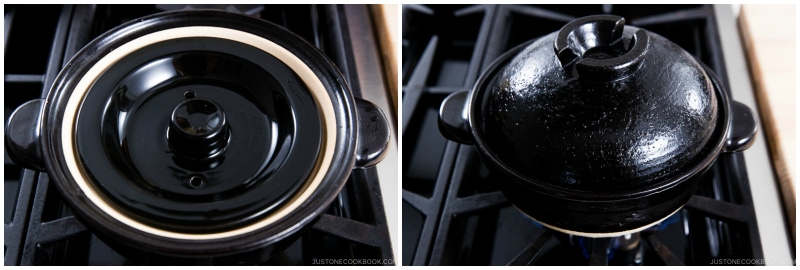
To Cook the Rice
- Set the donabe on a gas stovetop and turn the heat to medium high (or medium for a professional range). Cook* for 14 minutes for 4 servings (or find the cooking time below for your amount of rice). Alternately, simply watch for the steam to start puffing from the lid's hole, wait 2 minutes (for white rice), then turn off the heat.
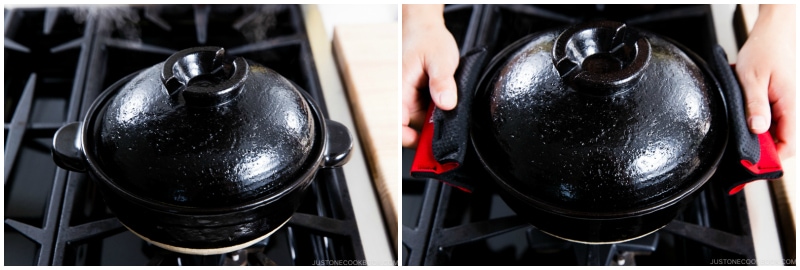
* White rice cooking times:
- For 1 rice cooker cup: Cook for 11–12 minutes (on medium heat); 2 cups: 12–14 minutes (medium-high heat); 3 cups: 13–15 minutes (medium-high heat); 4 cups: 14–16 minutes (medium-high heat); 5 cups: 15–17 minutes (medium-high heat).
* Brown rice cooking times:
- For 1 rice cooker cup: Cook for 22 minutes (on medium heat; turn off the heat 10 minutes after the steam starts puffing); 2 cups: 28–30 minutes (medium heat; turn off the heat 13–15 minutes after the steam starts puffing); 3 cups: 35–38 minutes (medium heat; turn off the heat 15–18 minutes after the steam starts puffing); 4 cups: 41–43 minutes (medium heat; turn off the heat 17–19 minutes after the steam starts puffing). 5 cups: 45–48 minutes (medium heat; turn off the heat 20–22 minutes after the steam starts puffing).
To Steam the Rice
- Remove from the stove and let the donabe stand with the lid on (both lids for the Kamado-san) for 20 minutes for white rice and 40 minutes for brown rice. Tip: This resting period is crucial for the rice to steam properly. Resist the urge to peek under the lid and release the steam during this time.
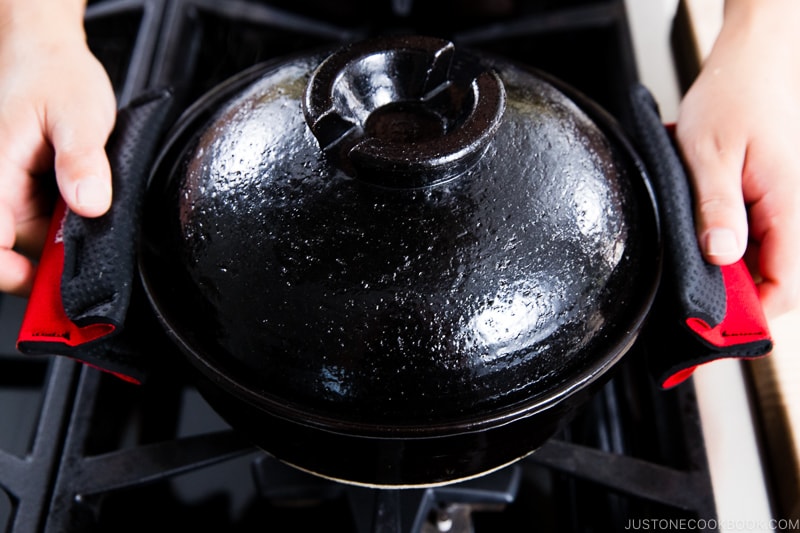
To Serve
- Fluff the rice with a rice paddle, and it‘s ready to serve.

To Store
- Transfer the cooked rice to airtight containers and close the lid to keep the moisture in. Let the rice cool completely before storing the containers in the freezer (read my tutorial post).
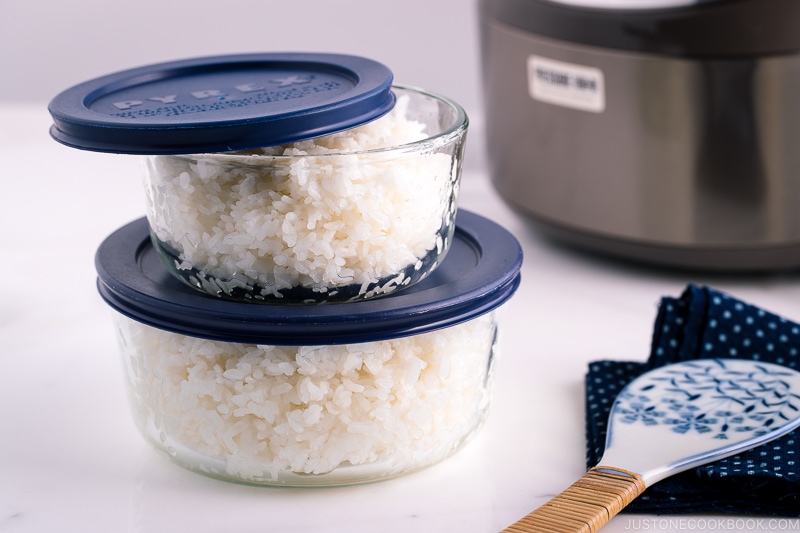
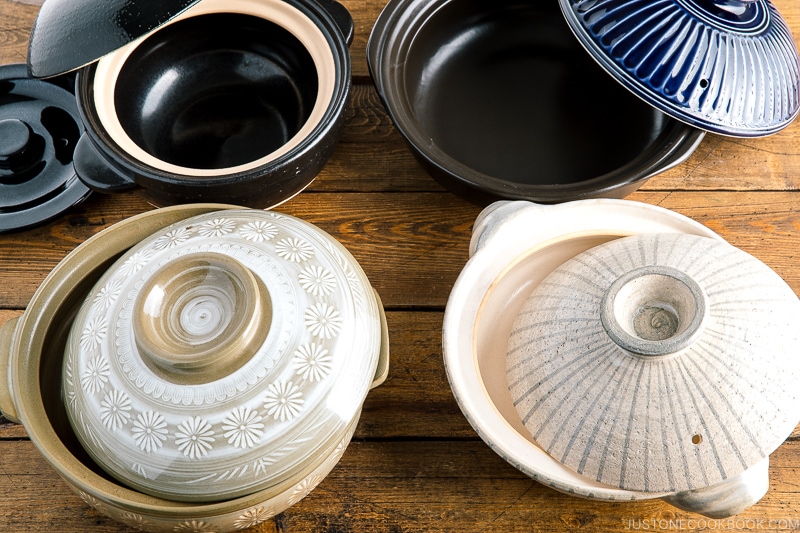
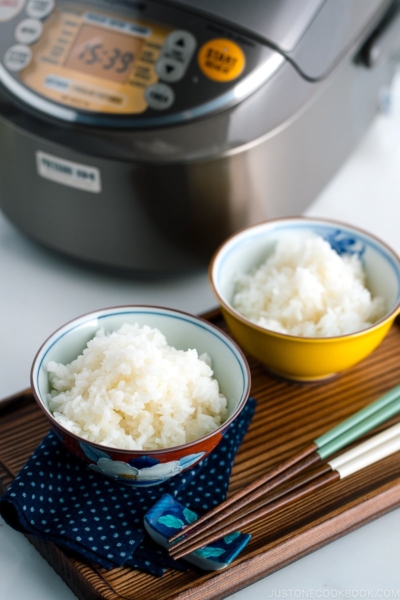
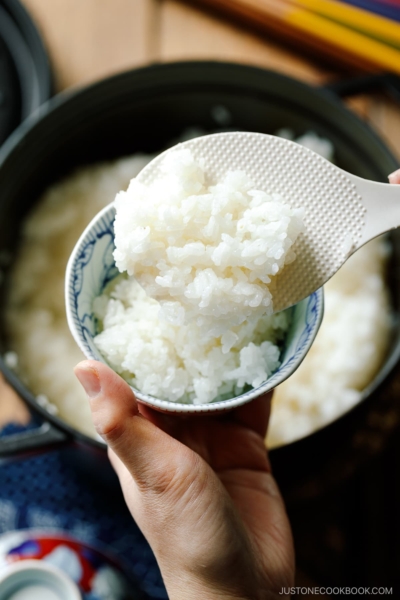
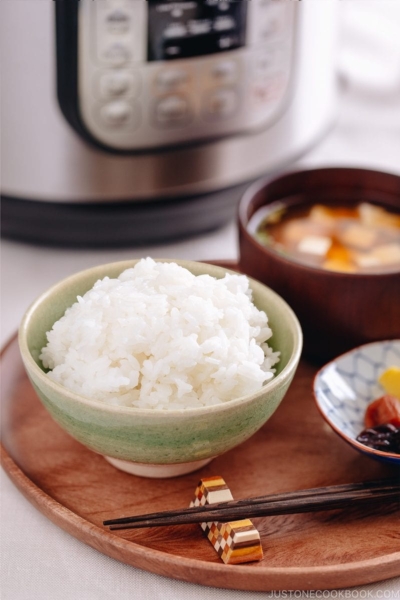
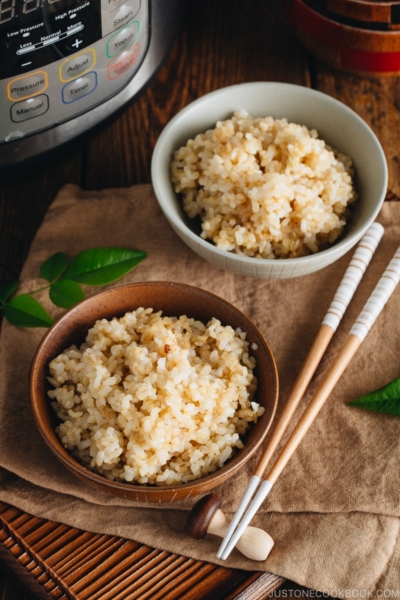




If I have a double-lid donabe for rice but I want to use it for other cooking as well (e.g. – nabeyaki udon etc) how should I wash it between other food and rice? Will I need to re-season it before cooking rice in it again?
Thank you for your time!
Hello, Lili. Thank you for reading Nami’s post!
You don’t have to re-season every time, but here’s a post explaining how to remove and take care of odors. We hope this post helps!
https://www.justonecookbook.com/how-to-season-your-donabe/